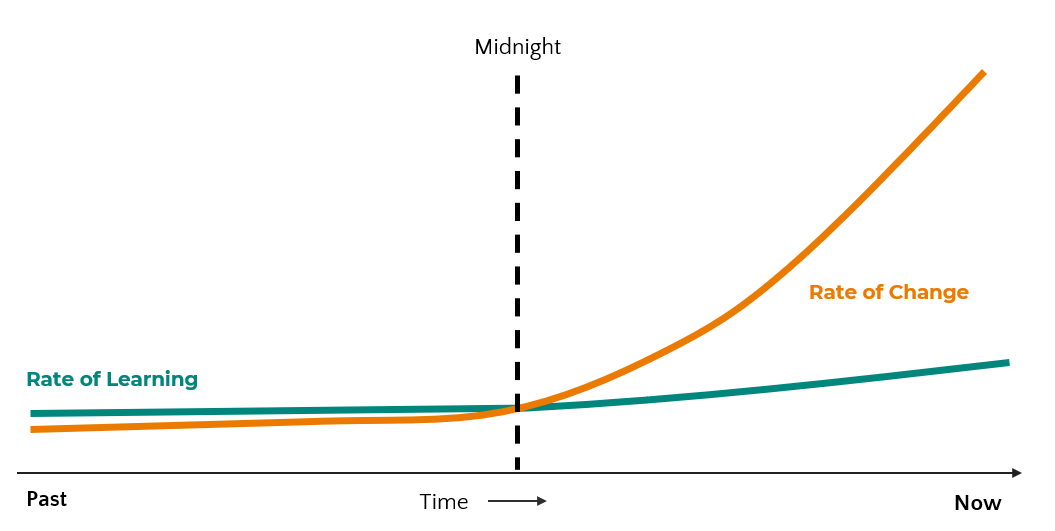Since its inception in the ‘90s, Agile has become mainstream, and you probably kind of understand what it means — you get the gist of it.
But by simply learning a few more things about why your organization wants agility, you will have more context in your work, and be able to contribute even more to your company’s success.
So, let’s start from the beginning:
What Agile and agility actually mean
Surprisingly, there is no universally accepted definition of “Agile” and “agility”. The two terms are often used synonymously, so let’s start this blog with some definitions.
Agile is a set of values, principles, and ways of working.
Agility is the practical application of Agile.
Further, agility is both:
- Finding a well-thought-out balance between DevOps, agile ways of working, and product thinking
- A strategic approach to developing the organization and its business. This means your agility impacts the whole organization, with the aim to give it a competitive advantage.
The general reason for adopting Agile and agility
It is pretty simple. In any software-intensive industry, your environment increasingly changes and becomes ever more unpredictable. So your organization needs to change to keep up with the competition to succeed.
In addition, your competition itself is changing as new players enter the market, changing both the technology and customer behavior.
All these changes are speeding up, which makes it more and more challenging to create successful products.
Let’s take a closer look at this for a minute — because there is a clever way to break it down.
“The World After Midnight” explains it best
The concept of “The World After Midnight,” invented by Dr. Eddie Obeng, clearly illustrates what you are up against.

Have a look at the green “Rate of Learning” curve in this figure. It tells us that in the world before midnight (the vertical line), companies have a solid understanding of customer needs, the future of the markets, and the industry in general. Life is good for the software and product teams.
In this environment, organizations are able to:
- identify the problem
- gather information about it
- design and create a product addressing the problem
- get it to the market
- capture the revenue
Simply put, organizations can dictate to the markets what they need to solve their problem.
But look at the orange “Rate of Change” curve: it increases. Customers become more aware of what they actually need, markets and industries diversify, and technologies mature. Once the Rate of Change passes the organization’s Rate of Learning, it creates sort of singularity. At that point, the organizations lose their ability to dictate the markets, and the rules of the old world become obsolete. This is when the Midnight falls.
To survive and thrive in this new world, organizations need a different rule book. They need to be able to:
- Prototype the problem
- Get it to the markets fast
- Capture feedback
- Iterate the solution
- Adapt it to meet the needs
This is the domain where Agile and agility are at their best: managing the ever-increasing uncertainty.
Don’t predict the future: anticipate it
A key benefit of agility is its ability to manage uncertainty, which can be defined as a lack of information.
When you start a new project, you often face a significant amount of uncertainty around the actual customer needs, existing market situation, technology landscape, and so on. The larger the effort, the longer it will take, and as a result, the amount of uncertainty increases. Essentially, you are betting on what the future will look like. The Waterfall approach tried to eradicate all uncertainty from the effort.
This. Is. Impossible.
In the words of management guru Peter Drucker, there are two things we know about the future:
- It cannot be known
- It will be different from what exists today, and it will be different from what we are now expecting it to be
The future is more or less of a black box, and any attempt to accurately foresee it will be fruitless due to its nature. Yet, you as an organization need a way to deal with this. Because you need to develop valuable products that satisfy your customers’ needs, and your organization needs to explore new opportunities, and so on. And all this must happen in a world full of unknowns.
This means that while you cannot predict what will happen in the future, you must anticipate the future effects of events that have already irrevocably happened.
Simply put: the outcomes of your actions are based on the decisions you make today.
This is where Agile ways of working are particularly suitable: agile methods are iterative and incremental. They create a much shorter cadence for examining the state of the work and its impacts, and therefore provide more frequent opportunities to adjust the course if required.
In traditional development approaches, you made a single huge bet about the future.
With agile methods, you place your bets in much smaller quantities.
After each iteration, you can stop and analyze if you are going in the right direction, and what you can learn from what has been done. The end of an increment is a decision-making point that, with increased understanding and less uncertainty, will help you to make more solid decisions and anticipations about the next increment and the effort itself.
Agility creates a winning employee experience
The people are your organization’s true asset — they can either make or break its success.
Agility has been proven to boost people's engagement and job satisfaction. This in turn has a positive impact on the financial performance and outcomes of the organization.
Engaged and happy employees = success
Intrinsic motivators vary, but one key thing your employees need to be motivated is autonomy. Agile methods empower employees by letting those with the best subject knowledge make decisions within agreed limits. In addition, people are given the ability to decide with appropriate independence how to do something in a way seen as most natural and best.
This puts people throughout the organization front and center. It gives them the mandate of owning their job, and an opportunity to make a significant contribution. This creates an acute sense of purpose, again one of the most common intrinsic motivators.
So agility makes financial sense. But it is also important in the context of the current labor market. Competition for professionals is fierce and employee retention is paramount for organizations to succeed. For this reason, a winning employee experience is vital, and both Agile and agility are excellent tools for this.
You need true agility instead of agile practices
As we discussed, agility is about managing uncertainty. And to achieve this, you need to accept that uncertainty exists, and you have to live with it. This often requires a radical shift in how you see, for example, planning and plans.
Planning is still important, but the plans themselves are always flawed. It’s easy to believe they are absolutely correct representations, they always reflect their makers’ best understanding at the given moment.
True agility is, therefore, not about Agile itself. Your organization can flawlessly use all the agile practices in the world, but still lack agility, if you are unwilling to change with the world around you.
This blog post is the first of a series of posts exploring transforming organizations into true and lasting agility. Read the second blog from the series: Understand why your organization wants to be Agile: The driving forces of agility.
Published: Feb 6, 2023
Updated: Jul 28, 2023


